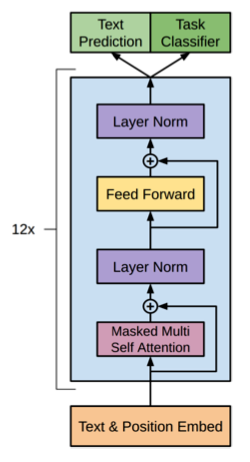GPT: Generative Pre-Trained Transformer (2018)
The First Version

In 2018, OpenAI released the first version of GPT (Generative Pre-Trained Transformer) for generating texts as if humans wrote. The architecture of GPT is based on the original transformer’s decoder.
They trained GPT in two stages:
- Unsupervised Pre-training pre-trains GPT on unlabeled text, which taps into abundant text corpora.
- Supervised Fine-tuning fine-tunes the pre-trained model for each specific task using labeled data.
This article gives an overview of each stage.
1 Unsupervised Pre-training
The purpose of this stage is to train the model to learn about the structure of the language and to capture the statistical patterns present in the text dataset. In other words, it is not aiming at a specific language task but at improving the model’s understanding of the language itself. The model learns to predict the next word in the sequence based on the context from the previous words (aka. generative pre-training). It’s like a smartphone keyboard suggesting the next word to type.
More concretely, when pre-training the model with unlabelled texts, they feed a sequence of tokens (i.e., part of a sentence) to the model (a variant of the Transformer decoder) to predict the probabilities for the next token. It is shown as “Text Prediction” in the below diagram (“Task Classifier” is for the supervised fine-tuning).

Mathematically, they use a common language modeling objective (i.e., predict the next token) to maximize the following likelihood
Since there are no labels or specific tasks to perform, they can use abundant text (previously hard-to-use) corpora. Given a huge amount of language data to learn from, the model can understand the language better, compared with supervised training, where we have much less text data available as it requires hand labeling.
2 Supervised Fine-tuning
After unsupervised pre-training, they fine-tune the pre-trained model for each specific task using labeled data (aka. discriminative fine-tuning). For a simple classification task, each input consists of a sequence of tokens and a label. They pass through the inputs to the pre-trained model to obtain the final activations, which are fed into an additional linear (+softmax) output layer. The objective of the training is to maximize the following likelihood
Additionally, they include language modeling as an auxiliary objective. In other words, the model also learns to maximize the
According to the paper, the auxiliary objective improves the following:
- Generalization of the supervised model (helping the model learn the dataset better)
- Convergence speed (reducing the loss faster)
3 Input Transformations
More complex tasks (than simple classification) require task-specific input transformations.

In all cases, inputs are processed by their pre-trained model, followed by a task-specific linear (+softmax) layer. The below explains each task-specific input transformation.
3.1 Textual Entailment
The task of textual entailment is to classify the relationship between a pair of texts, whether one entails the other. If a typical person would infer that the hypothesis (a text) is true given the premise (a text), the relationship is classified as an entailment, that is, the hypothesis entails the premise. If there is an inconsistency between the two, the relationship is classified as a contradiction. If neither is true, the relationship is classified as neutral.
Therefore, the input of an entailment task consists of the following:
- Start token
- Premise (a text)
- Delimiter token ($)
- Hypothesis (a text)
- End (Extract) token
3.2 Similarity
For similarity tasks, there is no directional relationship between the two sentences being compared. Therefore, the input sequence contains both possible ordering.
- Start, Text 1, Delimiter, Text 2, Extract
- Start, Text 2, Delimiter, Text 1, Extract
Both sequences are independently processed to produce two sequence representations, combined element-wise, before being fed into the linear output layer.
3.3 Question Answering and Commonsense Reasoning
These tasks provide a context document
- Start token
- Context document
- Delimiter token ($)
- One of the possible answers
- Extract
So, each input sequence looks like below:
- Start, Document
- Start, Document
- Start, Document
- …
Each sequence is independently processed and all outputs are normalized via the softmax layer to produce a distribution over possible answers.
4 Experimental Results
In summary, the training approach of GPT is to use unsupervised pre-training to boost performance on discriminative tasks. They trained a 12-layer decoder-only transformer.
For unsupervised pre-training, they used the BooksCorpus dataset, which contains over 7,000 unique unpublished books (Adventure, Fantasy, and Romance).
For supervised fine-tuning, they used the following datasets:
- Natural Language Inference
- SNLI
- MultiNLI
- Question NLI
- RTE
- SciTail
- Question Answsering
- RACE
- Story Close
- Sentence Similarity
- MSR Paraphrase Corpus
- Quora Question Pairs
- STS Benchmark
- Classification
- Stanford Sentiment Treebank-2
- CoLA
The below are the results on natural language inference tasks. The bottom row shows the GPT’s results, outperforming other models in most of tasks.

The below are the results on question answering and commonsense reasoning. The bottom row shows the GPT’s results, outperforming other models.

5 Analysis
The below left chart shows the performence improvement over the number of layers from pre-trained model (up to 12-layers) to transfer for supervised tasks. Each transformer layer provides more benefits, indicating eacy layer contains useful functionality for solving target tasks.

The right plot shows zero-shot behaviors where they designed a series of heuristic solutions to use the pre-trained model to perform tasks without supervised fine-tuning (therefore, it’s zero-shot). As we can see, the performance of GPT (solid lines) improves over the course of generative unsupervised pre-training. In comparison, LSTM does not perform as much in such zero-shot experiment.
Their hypothesis is that GPT without fine-tuning can perform many of the tasks, thanks to its language modeling capability. GPT aquires such capability from the generative pre-training, using the attention mechanism of the transformer, causing it to outperform LSTM in zero-shot experiments.